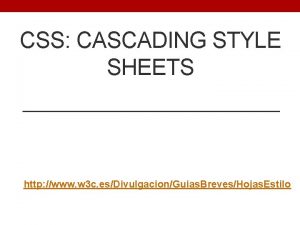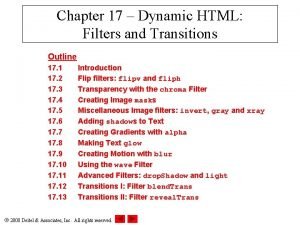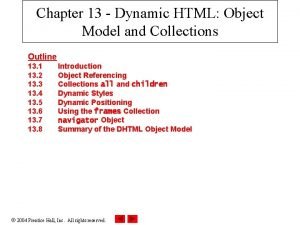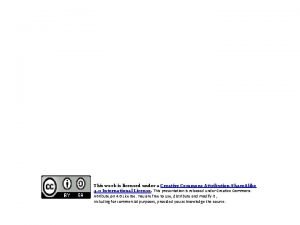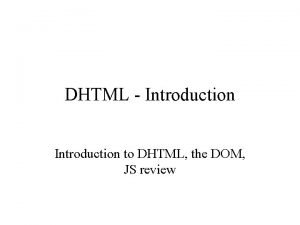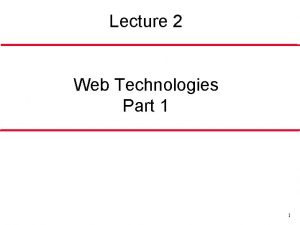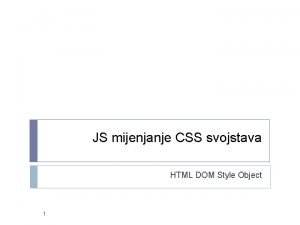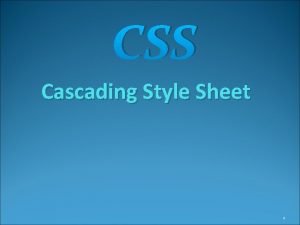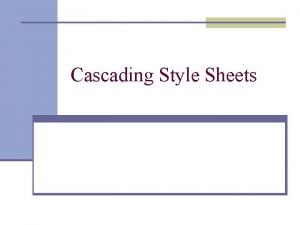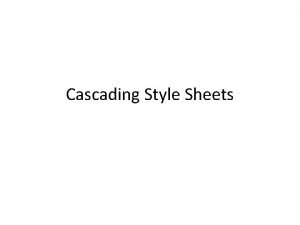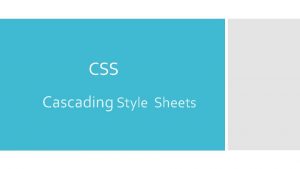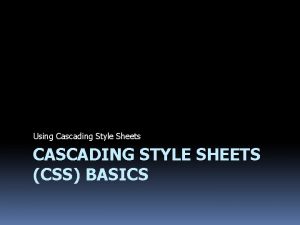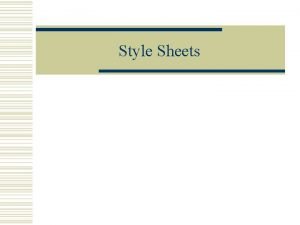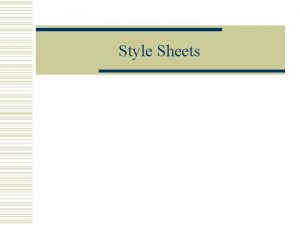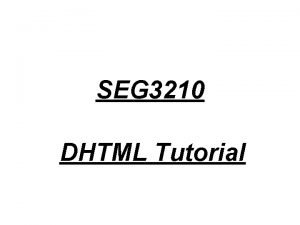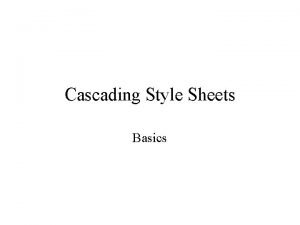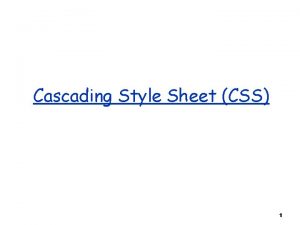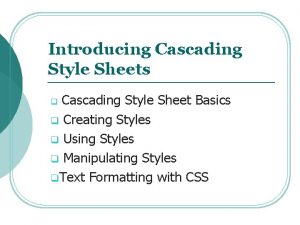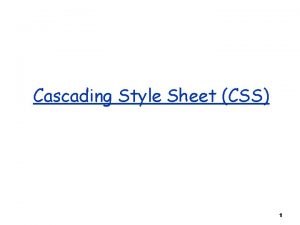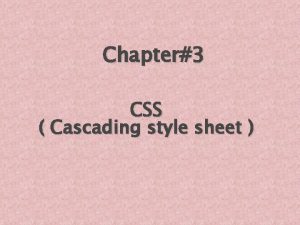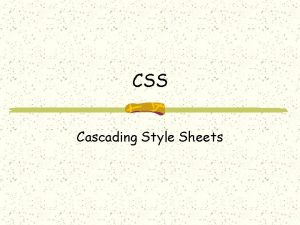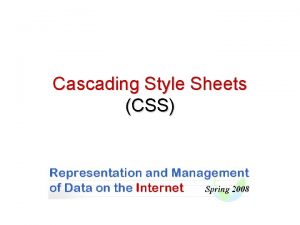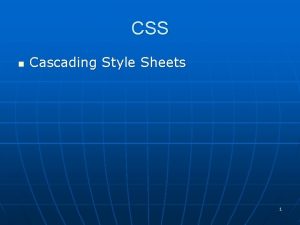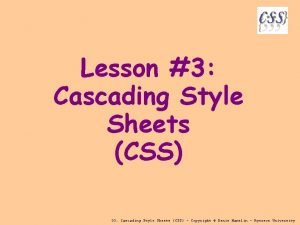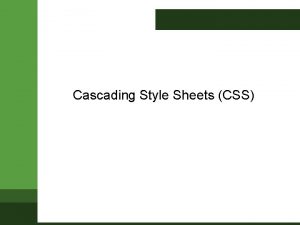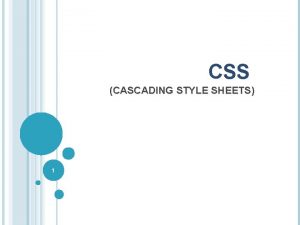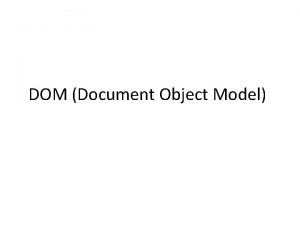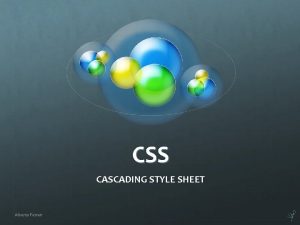Advanced DHTML DOM Review of Cascading Style Sheets


























- Slides: 26

Advanced DHTML & DOM: Review of Cascading Style Sheets Copyright © 2005 Department of Computer & Information Science

Goals By the end of this lecture you should … • Understand how to write CSS rules. • Understand how to apply a style to multiple selectors. • Understand how to use contextual selectors. continued … Copyright © 2005 Department of Computer & Information Science

Goals By the end of this lecture you should … • Understand how to create CSS custom classes. • Understand how to use id selectors. • Understand how to create layers using CSS. Copyright © 2005 Department of Computer & Information Science

Types of Cascading Style Sheets • Current W 3 C recommendations support three types of styles: – External (Multi-page scope) – Embedded (Page-level scope) – Inline (Element-level scope) Copyright © 2005 Department of Computer & Information Science

Style Rules • All styles depend on rules. Programmers construct rules using selectors and declarations. • Selectors represent the element or class to which the style should apply. • Declarations include the attribute to which the rule should apply and the new attribute value. Copyright © 2005 Department of Computer & Information Science

Rule Architecture – General Form selector { attribute: value; attribute 2: value 2; } (varies for inline styles) Copyright © 2005 Department of Computer & Information Science

Open the file called reviewing. CSS_01. html Copyright © 2005 Department of Computer & Information Science

Order of Precedence • The cascading order of precedence for styles, starting with the least important to the most important, is as follows: 1. Browser default 2. External style sheets 3. Internal style sheets 4. Inline styles Copyright © 2005 Department of Computer & Information Science

Applying a Style to Multiple Selectors • You can apply the same style to multiple selectors by listing the selectors in a comma-delimited list: p, li { font-size: 14 pt; font-color: red; } Copyright © 2005 Department of Computer & Information Science

Contextual Selectors • Contextual selectors only apply styles under certain circumstances. For example, the follow style would apply only for <em> elements nested inside a <li> element: li em { font-size: 14 pt; font-color: red; } Copyright © 2005 Department of Computer & Information Science

Classes • We can create classes to apply certain styles not to all elements in a group, but to specifically identified elements (those elements that match with the class attribute). • We can create classes to apply only to a given XHTML element (by also identifying the tag name) or to apply to any element we choose (lacks a specific tag name). Copyright © 2005 Department of Computer & Information Science

Class Example 1 p. alert { color: #ffffff; background-color: #ff 0000; font-weight: bold; } Copyright © 2005 Department of Computer & Information Science

Applying the Previous Class <p class=“alert”> This represents some text. </p> Copyright © 2005 Department of Computer & Information Science

Class Example 2. alert { color: #ffffff; background-color: #ff 0000; font-weight: bold; } Copyright © 2005 Department of Computer & Information Science

Applying the Previous Class <p class=“alert”> This represents some text. </p> … <h 1 class=“alert”> This represents some text. </h 1> Copyright © 2005 Department of Computer & Information Science

Open the file called reviewing. CSS_02. html Copyright © 2005 Department of Computer & Information Science

Using <div> and <span> • The <div> element formats a group of block-level and inline elements with styles, whereas the <span> element formats a group of inline elements • The only difference between these two elements is that the <div> element can contain block-level elements and also adds a line break after its closing tag. Copyright © 2005 Department of Computer & Information Science

id Selectors • If we want to apply a style once, to a very specific element, we can create an id selector, using the syntax: #Apply. Once { color: #ff 0000; background-color: #ffffff; } Copyright © 2005 Department of Computer & Information Science

Using id Selectors • To use id selector styles, we just need to create the element and name it using the id attribute: <p id=“Apply. Once”> This text is red. </p> Copyright © 2005 Department of Computer & Information Science

Creating Layers • We can use layers to create elements which we can move, make appear or make disappear. • Layers represent rectangular areas that are positioned along the X, Y and Z axes. Copyright © 2005 Department of Computer & Information Science

Open the file called reviewing. CSS_03. html Copyright © 2005 Department of Computer & Information Science

Introducing the Z-Axis • • • x = Horizontal Axis y = Vertical Axis z = “Depth” Axis (Stacking Order) – Specified by the “zindex” property – Think of the z axis pointing from the monitor towards you Copyright © 2005 Department of Computer & Information Science

Creating a Layer • We create layers using the <div> element and associated styles. • Important Layer Attributes: üposition üleft ütop ü height ü width ü z-index Copyright © 2005 Department of Computer & Information Science

Open the file called reviewing. CSS_04. html Copyright © 2005 Department of Computer & Information Science

Summary • Style rules are comprised of selectors and declarations. • We can apply a rule to multiple selectors by separating each selector with a comma when creating a rule. • We can use contextual selectors to apply a style only under given circumstances. continued … Copyright © 2005 Department of Computer & Information Science

Summary • We can create custom classes to apply styles to multiple difference elements. • We can use CSS to create layers, which can overlap one another by specifying a Zindex value. • We can show/hide individual layers by adjusting the visibility attribute of a layer. Copyright © 2005 Department of Computer & Information Science
 Cascading style sheets outlook
Cascading style sheets outlook Cascading style sheets definition
Cascading style sheets definition Syntactically awesome stylesheets
Syntactically awesome stylesheets Vertical blinds
Vertical blinds Object model and collections in dhtml
Object model and collections in dhtml Dhtml stands for
Dhtml stands for Dhtml introduction
Dhtml introduction Is dhtml new language explain shortly
Is dhtml new language explain shortly Dhtml form
Dhtml form Webclient nn
Webclient nn Dhtml
Dhtml Html style object
Html style object Perbedaan cascading dan pohon kinerja
Perbedaan cascading dan pohon kinerja Fractional cascading
Fractional cascading Dynamic logic circuits
Dynamic logic circuits Displacement step diagram
Displacement step diagram Customer intimacy strategy map
Customer intimacy strategy map Cascading consequences
Cascading consequences Cascading behavior in networks
Cascading behavior in networks Vin+
Vin+ Mnemonic code
Mnemonic code Cascode amplifier small signal model
Cascode amplifier small signal model Ons instruction
Ons instruction Beda pohon kinerja dan cascading
Beda pohon kinerja dan cascading Vertical-align trong css
Vertical-align trong css Cascading effect definition
Cascading effect definition Cascading flowers calder
Cascading flowers calder

